Fig. 4

Temporal evolution of semimajor axes a(t), periastron distances qp and apoastron distances Qa of four embryos with the initial mass 3 ME in three distinct simulation cases: Case I neglecting the pebble disk (top), Case II including the pebble disk but only allowing for the mass growth of embryos by pebble accretion (middle) and finally Case III, considering also the effect of accretion heating (bottom). Embryos are numbered from 1 to 4. Additional arrows and labels indicate mergers or coorbital pairs detected in the simulations, with corresponding embryo masses which can grow by pebble accretion (Cases II and III) or merging. Striking differences are observed in Case III as the migration rates are modified by the heating torque, orbits become moderately eccentric shortly after the simulation starts and the evolution is more violent compared to Cases I and II.
Current usage metrics show cumulative count of Article Views (full-text article views including HTML views, PDF and ePub downloads, according to the available data) and Abstracts Views on Vision4Press platform.
Data correspond to usage on the plateform after 2015. The current usage metrics is available 48-96 hours after online publication and is updated daily on week days.
Initial download of the metrics may take a while.





